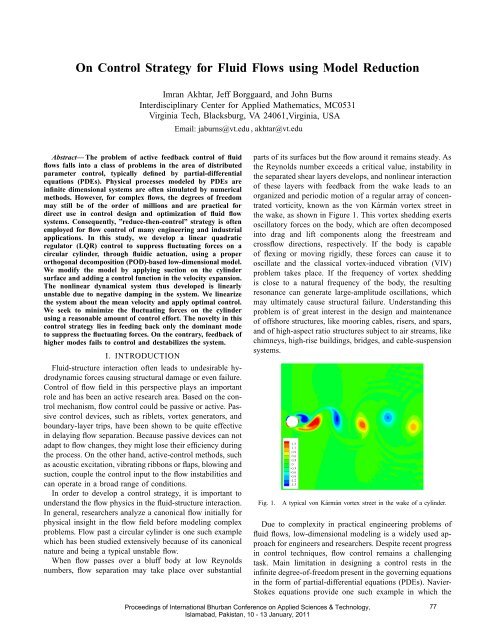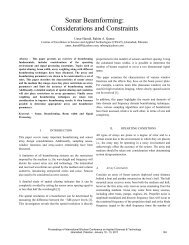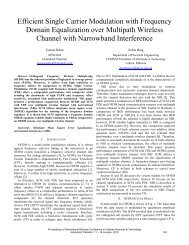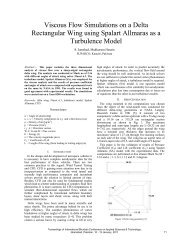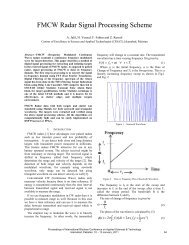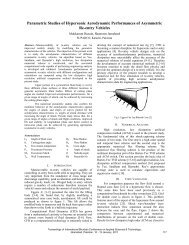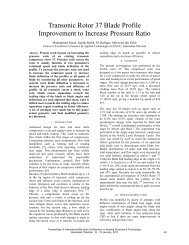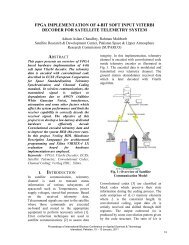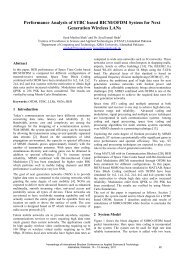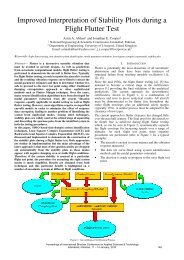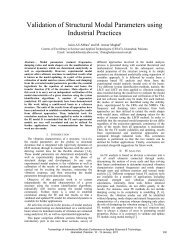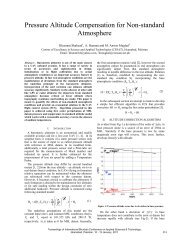On Control Strategy for Fluid Flows using Model Reduction - Ibcast
On Control Strategy for Fluid Flows using Model Reduction - Ibcast
On Control Strategy for Fluid Flows using Model Reduction - Ibcast
Create successful ePaper yourself
Turn your PDF publications into a flip-book with our unique Google optimized e-Paper software.
<strong>On</strong> <strong>Control</strong> <strong>Strategy</strong> <strong>for</strong> <strong>Fluid</strong> <strong>Flows</strong> <strong>using</strong> <strong>Model</strong> <strong>Reduction</strong><br />
Imran Akhtar, Jeff Borggaard, and John Burns<br />
Interdisciplinary Center <strong>for</strong> Applied Mathematics, MC0531<br />
Virginia Tech, Blacksburg, VA 24061,Virginia, USA<br />
Email: jaburns@vt.edu , akhtar@vt.edu<br />
Abstract— The problem of active feedback control of fluid<br />
flows falls into a class of problems in the area of distributed<br />
parameter control, typically defined by partial-differential<br />
equations (PDEs). Physical processes modeled by PDEs are<br />
infinite dimensional systems are often simulated by numerical<br />
methods. However, <strong>for</strong> complex flows, the degrees of freedom<br />
may still be of the order of millions and are practical <strong>for</strong><br />
direct use in control design and optimization of fluid flow<br />
systems. Consequently, ”reduce-then-control” strategy is often<br />
employed <strong>for</strong> flow control of many engineering and industrial<br />
applications. In this study, we develop a linear quadratic<br />
regulator (LQR) control to suppress fluctuating <strong>for</strong>ces on a<br />
circular cylinder, through fluidic actuation, <strong>using</strong> a proper<br />
orthogonal decomposition (POD)-based low-dimensional model.<br />
We modify the model by applying suction on the cylinder<br />
surface and adding a control function in the velocity expansion.<br />
The nonlinear dynamical system thus developed is linearly<br />
unstable due to negative damping in the system. We linearize<br />
the system about the mean velocity and apply optimal control.<br />
We seek to minimize the fluctuating <strong>for</strong>ces on the cylinder<br />
<strong>using</strong> a reasonable amount of control ef<strong>for</strong>t. The novelty in this<br />
control strategy lies in feeding back only the dominant mode<br />
to suppress the fluctuating <strong>for</strong>ces. <strong>On</strong> the contrary, feedback of<br />
higher modes fails to control and destabilizes the system.<br />
I. INTRODUCTION<br />
<strong>Fluid</strong>-structure interaction often leads to undesirable hydrodynamic<br />
<strong>for</strong>ces ca<strong>using</strong> structural damage or even failure.<br />
<strong>Control</strong> of flow field in this perspective plays an important<br />
role and has been an active research area. Based on the control<br />
mechanism, flow control could be passive or active. Passive<br />
control devices, such as riblets, vortex generators, and<br />
boundary-layer trips, have been shown to be quite effective<br />
in delaying flow separation. Because passive devices can not<br />
adapt to flow changes, they might lose their efficiency during<br />
the process. <strong>On</strong> the other hand, active-control methods, such<br />
as acoustic excitation, vibrating ribbons or flaps, blowing and<br />
suction, couple the control input to the flow instabilities and<br />
can operate in a broad range of conditions.<br />
In order to develop a control strategy, it is important to<br />
understand the flow physics in the fluid-structure interaction.<br />
In general, researchers analyze a canonical flow initially <strong>for</strong><br />
physical insight in the flow field be<strong>for</strong>e modeling complex<br />
problems. Flow past a circular cylinder is one such example<br />
which has been studied extensively because of its canonical<br />
nature and being a typical unstable flow.<br />
When flow passes over a bluff body at low Reynolds<br />
numbers, flow separation may take place over substantial<br />
parts of its surfaces but the flow around it remains steady. As<br />
the Reynolds number exceeds a critical value, instability in<br />
the separated shear layers develops, and nonlinear interaction<br />
of these layers with feedback from the wake leads to an<br />
organized and periodic motion of a regular array of concentrated<br />
vorticity, known as the von Kármán vortex street in<br />
the wake, as shown in Figure 1. This vortex shedding exerts<br />
oscillatory <strong>for</strong>ces on the body, which are often decomposed<br />
into drag and lift components along the freestream and<br />
crossflow directions, respectively. If the body is capable<br />
of flexing or moving rigidly, these <strong>for</strong>ces can cause it to<br />
oscillate and the classical vortex-induced vibration (VIV)<br />
problem takes place. If the frequency of vortex shedding<br />
is close to a natural frequency of the body, the resulting<br />
resonance can generate large-amplitude oscillations, which<br />
may ultimately cause structural failure. Understanding this<br />
problem is of great interest in the design and maintenance<br />
of offshore structures, like mooring cables, risers, and spars,<br />
and of high-aspect ratio structures subject to air streams, like<br />
chimneys, high-rise buildings, bridges, and cable-suspension<br />
systems.<br />
Fig. 1.<br />
A typical von Kármán vortex street in the wake of a cylinder.<br />
Due to complexity in practical engineering problems of<br />
fluid flows, low-dimensional modeling is a widely used approach<br />
<strong>for</strong> engineers and researchers. Despite recent progress<br />
in control techniques, flow control remains a challenging<br />
task. Main limitation in designing a control rests in the<br />
infinite degree-of-freedom present in the governing equations<br />
in the <strong>for</strong>m of partial-differential equations (PDEs). Navier-<br />
Stokes equations provide one such example in which the<br />
Proceedings of International Bhurban Conference on Applied Sciences & Technology,<br />
Islamabad, Pakistan, 10 - 13 January, 2011<br />
77
presence of nonlinearity increases complexity of design and<br />
application of control. Low-dimensional modeling provides<br />
pratcial solutions <strong>for</strong> extremely challenging problems [1].<br />
<strong>Model</strong> reduction may be viewed as representing a physical<br />
phenomenon by a few number of equations or physically<br />
reducing the infinite or large dimensions of the problem. The<br />
<strong>for</strong>mer may be termed as phenomenological modeling while<br />
the latter is a more direct and conventional approach to model<br />
reduction.<br />
In phenomenological modeling, a flow-related phenomenon<br />
is modeled by a small degrees of freedom system.<br />
<strong>On</strong>e such example is vortex shedding in a bluff body wake.<br />
Several analytical approaches have been proposed to model<br />
vortex shedding over a circular cylinder. Bishop and Hassan<br />
[2] were among the earliest to suggest <strong>using</strong> a self-excited<br />
oscillator (Rayleigh or van der Pol oscillators) to represent<br />
the <strong>for</strong>ces over a cylinder due to vortex shedding. Several<br />
other analytical models were extended to elastic and moving<br />
cylinders [3], [4], [5], [6], [7]. Later, such models have been<br />
modified <strong>for</strong> various flow parameters [8](such as Reynolds<br />
numbers, <strong>for</strong>cing amplitudes etc.) or change in geometric<br />
parameters [9]. Other examples include modeling of heartbeat,<br />
current in RLC circuit, etc. <strong>using</strong> self-excited oscillator<br />
models.<br />
Many low-dimensional model techniques in fluid mechanics<br />
are derived from the proper orthogonal decomposition<br />
(POD)-Galerkin projection approach [10], [11]. The POD<br />
provides a tool to <strong>for</strong>mulate an optimal basis or minimum<br />
degrees of freedom (or modes) required to represent a<br />
dynamical system. The POD is also known as the Karhunen-<br />
Loeve expansion in statistics and principal component analysis<br />
or empirical orthogonal functions (EOF) in meteorology.<br />
The POD-Galerkin low-dimensional models are constructed<br />
in two steps:<br />
1) Computation of the POD basis functions from the data<br />
ensemble of the flow field.<br />
2) Galerkin projection of the Navier-Stokes equations<br />
onto a space spanned be a small number of POD basis<br />
functions.<br />
In the first step, the variables from the high-fidelity simulation<br />
(typically CFD) are transferred to a finite number<br />
of basis functions or modes, which are relatively small in<br />
number as compared to the degrees of freedom involved<br />
in the simulation. The second step involves a translation<br />
of the full-system dynamics to the implied dynamics of<br />
these modes. The resulting dynamical system consists of<br />
a set of ODEs in time in the modal amplitudes. Thus,<br />
low-dimensional models obtained from this procedure can<br />
be used to apply a control strategy. This application of<br />
control design at the analytical level will be beneficial <strong>for</strong><br />
the design of a controller in the real-time system. Some<br />
other applications of low-dimensional models include shape<br />
optimization, aeroelastic stability analysis, and understanding<br />
of the nonlinear dynamics of the system. A schematic of the<br />
hierarchy of flow models is represented in Figure 2 where<br />
the degrees of freedom are systematically reduced while<br />
preserving the physics and dominant features of the flow.<br />
A block diagram depicting the low-dimensional modeling proce-<br />
Fig. 2.<br />
dure.<br />
POD based low-dimensional models have been successfully<br />
implemented <strong>for</strong> various control strategies. In the current<br />
work, we would restrict ourselves only to the literature<br />
foc<strong>using</strong> on optimal control of vortex shedding past a circular<br />
cylinder. Graham et al. [12] developed a low-dimensional<br />
model <strong>for</strong> the flow past a circular cylinder at Re = 100 <strong>using</strong><br />
numerical simulations and the control action was achieved<br />
by cylinder rotation. They introduced two approaches to<br />
incorporate variable input control in the low-dimensional<br />
model. In the first approach, known as the “control function<br />
method,” a suitable control function is included in the velocity<br />
expansion to account <strong>for</strong> the inhomogeneous boundary<br />
conditions on the cylinder surface. The POD modes, used in<br />
the modified expansion, retain the homogeneous boundary<br />
conditions. In the second approach, the “penalty method,” the<br />
velocity expansion remains the same as <strong>for</strong> the unactuated<br />
flow and the essential boundary condition is en<strong>for</strong>ced in an<br />
integral “weak” fashion.<br />
Singh et al. [13] used these two approaches <strong>for</strong> controlling<br />
the cylinder wake. The models were based on POD of the<br />
two-dimensional incompressible, unsteady wake flow behind<br />
a circular cylinder at Re = 100. Linear optimal control theory<br />
was used to develop the feedback gains. Their simulations<br />
of the modes showed that, in a closed-loop system, asymptotic<br />
regulation of the amplitudes to the desired equilibrium<br />
state could be accomplished by appropriately rotating the<br />
cylinder. Also, they found that their linear controller was<br />
capable of suppressing large unsteady perturbations, despite<br />
the presence of nonlinearity in the flow dynamics of the two<br />
models.<br />
Bergmann et al. [14] employed optimal control approach<br />
Proceedings of International Bhurban Conference on Applied Sciences & Technology,<br />
Islamabad, Pakistan, 10 - 13 January, 2011<br />
78
to reduce the drag on the cylinder at Reynolds number of<br />
200 <strong>using</strong> cylinder rotation. They used the time angular<br />
velocity of the rotating cylinder as the cost function. They<br />
developed POD-based reduced order model and introduced<br />
time-dependent eddy-viscosity estimated <strong>for</strong> each POD mode<br />
as the solution of an auxiliary optimization problem. They<br />
used Lagrange multipliers to en<strong>for</strong>ce constraints to solve<br />
optimization problem and achieved 25% of relative drag<br />
reduction.<br />
Siegel et al. [15] numerically studied the effect of feedback<br />
flow control on the cylinder wake at Re = 100. The controller<br />
applies linear proportional and differential feedback to<br />
the estimate of the first POD mode. Actuation is implemented<br />
as the displacement of the cylinder normal to the flow<br />
while the sensors were placed in the wake. They observed a<br />
reduction of 15% and 90% of drag and lift, respectively.<br />
Bergmann and Cordier [16] used optimal control theory<br />
to minimize the mean drag <strong>for</strong> a circular cylinder with<br />
amplitude and frequency as the control parameters <strong>using</strong><br />
cylinder rotation. They employed trust-region POD approach<br />
in the wake which converged to the minimum predicted by<br />
an open-loop control approach and leads to a relative mean<br />
drag reduction of 30%.<br />
In this study, we follow an optimal control strategy to<br />
minimize the fluctuating <strong>for</strong>ces. Most of the studies mentioned<br />
have used cylinder rotation as the means of actuation.<br />
In this study, we use suction jet as the actuator. We also<br />
define the objective function based on the lift coefficient. We<br />
develop a POD-based low-dimensional model <strong>using</strong> a control<br />
function approach based on suction on the cylinder surface.<br />
We feedback only the dominant (first) state of the system and<br />
compute appropriate gains. Successful application of optimal<br />
control on the low-dimensional model suggests that the<br />
fluctuating <strong>for</strong>ces can be completely suppressed <strong>using</strong> suction<br />
actuators. The manuscript is organized as follows; Section<br />
II presents the numerical methodology used to simulate the<br />
flow past a circular cylinder. In Section III, we discuss the<br />
methodology to compute POD basis functions and compute<br />
them <strong>for</strong> the two-dimensional problem. In Section IV, we<br />
develop a reduced-order model <strong>for</strong> the unactuated flow field.<br />
Later, we discuss control function method and develop a<br />
reduced-order model <strong>for</strong> the actuated flow field. In Section<br />
V, we design an LQR control based on the linearized model<br />
and numerically integrate the system to show suppression of<br />
system response.<br />
II. NUMERICAL METHODOLOGY<br />
where the flux is defined as<br />
F im = U m u i + J −1 ∂ξ m<br />
∂x i<br />
p − 1 Re Gmn ∂u i<br />
∂ξ n<br />
. (3)<br />
−1 ∂ξm<br />
∂x j<br />
∂ξ n<br />
∂x j<br />
Here Re = U∞D<br />
ν<br />
; J −1 = det ( ∂x i<br />
)<br />
∂ξ j<br />
is the inverse of the<br />
−1 ∂ξm<br />
Jacobian or the volume of the cell; U m = J<br />
∂x j<br />
u j is the<br />
volume flux (contravariant velocity multiplied by J −1 ) normal<br />
to the surface of constant ξ m ; and G mn = J<br />
is the “mesh skewness tensor.”<br />
A semi-implicit scheme is employed to advance the solution<br />
in time. The diagonal viscous terms are advanced<br />
implicitly <strong>using</strong> the second-order accurate Crank-Nicolson<br />
method, whereas all of the other terms are advanced <strong>using</strong><br />
the second-order accurate Adams-Bash<strong>for</strong>th method. The<br />
Adams-Bash<strong>for</strong>th scheme was chosen because of its computational<br />
efficiency when coupled with the fractional step<br />
method. Details of the numerical algorithm, validation and<br />
verification can be found in Ref. [17], [9], [18]. <strong>Fluid</strong>ic<br />
actuation (suction, blowing, or synthetic jets) on the cylinder<br />
surface can be used as a controlling mechanism <strong>for</strong> the flow<br />
field. The actuator is modeled by imposing a fixed or timevarying<br />
velocity normal to the cylinder surface [19].<br />
The fluid <strong>for</strong>ce on a cylinder is the manifestation of the<br />
pressure and shear stresses acting on its surface. The net<br />
<strong>for</strong>ce can be decomposed into two components: lift and drag<br />
<strong>for</strong>ces. These <strong>for</strong>ces are nondimensionalized with respect to<br />
the dynamic pressure. The coefficients of lift and drag can<br />
thus be written in terms of the dimensional pressure and<br />
shear stresses as follows:<br />
C L = − 1<br />
ρU 2 ∞<br />
C D = − 1<br />
ρU 2 ∞<br />
∫2π<br />
(<br />
p sin θ − 1 )<br />
Re ω z cosθ dθ<br />
0<br />
∫2π<br />
(<br />
p cosθ + 1 )<br />
Re ω z sin θ dθ<br />
0<br />
(4a)<br />
(4b)<br />
where ω z is the spanwise vorticity component on the<br />
cylinder surface.<br />
III. POD BASIS FUNCTIONS<br />
A parallel CFD solver is used to simulate the flow past a<br />
circular cylinder [17], [18]. The governing equations are the<br />
Navier-Stokes equations in curvilinear coordinates (ξ m ) and<br />
can be written in strong conservation <strong>for</strong>m as follows:<br />
∂(J −1 u i )<br />
∂t<br />
∂U m<br />
∂ξ m<br />
= 0, (1)<br />
+ ∂F im<br />
∂ξ m<br />
= 0, (2)<br />
In this section, we provide the procedure <strong>for</strong> computing<br />
the POD basis functions <strong>for</strong> two-dimensional flow fields. The<br />
flow field data (u, v) is generated from an experiment or a<br />
numerical simulation and is assembled in a matrix W 2N×S ,<br />
as shown in equation (5); each column represents one time<br />
instant or a snapshot and S is the total number of snapshots<br />
<strong>for</strong> N grid points in the domain. The vorticity field can also<br />
be used <strong>for</strong> POD, however, in the case of the velocity field,<br />
the singular values are a direct measure of the kinetic energy<br />
Proceedings of International Bhurban Conference on Applied Sciences & Technology,<br />
Islamabad, Pakistan, 10 - 13 January, 2011<br />
79
in each mode.<br />
⎡<br />
W =<br />
⎢<br />
⎣<br />
u (1)<br />
1 u (2)<br />
1 . . . u (S)<br />
1<br />
. . .<br />
u (1)<br />
N<br />
u (2)<br />
N<br />
. . . u (S)<br />
N<br />
v (1)<br />
1 v (2)<br />
1 . . . v (S)<br />
1<br />
. . .<br />
. . .<br />
v (1)<br />
N<br />
v (2)<br />
N<br />
. . . v (S)<br />
N<br />
Mathematically, we compute Φ <strong>for</strong> which the following<br />
quantity is maximum:<br />
〈|u, Φ| 2〉<br />
⎤<br />
⎥<br />
⎦<br />
(5)<br />
‖Φ‖ 2 , (6)<br />
where Φ are the POD basis functions and 〈.〉 denotes the<br />
ensemble average. Applying variational calculus, one can<br />
show that equation (6) is equivalent to a Fredholm integral<br />
eigenvalue problem represented as<br />
In the classical POD or direct method, originally introduced<br />
by Lumley [20], a two-point spatial-correlation tensor<br />
is <strong>for</strong>med and the eigenfunctions are the POD modes. In<br />
this approach, the average operator is estimated in time. <strong>On</strong><br />
the other hand, if the average operator is evaluated as a<br />
space average over the domain of interest, the method is<br />
known as the method of snapshot [21]. In this approach, we<br />
<strong>for</strong>mulate a temporal-correlation function from the snapshots<br />
and trans<strong>for</strong>m it into an eigenvalue problem.<br />
In this study, we compute the singular value decomposition<br />
(SVD) of the data ensemble W to obtain the POD modes,<br />
i.e. W = UΣV T , where U represents the POD basis. This<br />
method has a limited application, especially when the grid<br />
size (N) is large. [22] proposed an algorithm, inspired<br />
from domain decomposition ideas, <strong>for</strong> a scalable parallel<br />
efficient computation of the POD basis vector with low<br />
communication overhead. An SVD of a (spatial) subdomain<br />
time history is calculated locally on each processor followed<br />
by the exchange of a small number of dominant V p (right singular<br />
vector on the p th processor) with other processors. An<br />
iterative application of this step showed promising results <strong>for</strong><br />
complex fluid flows, gravity currents, and two-dimensional<br />
flow past a square cylinder. Thus,<br />
⎡<br />
U =<br />
⎢<br />
⎣<br />
φ (u)<br />
1,1 φ (u)<br />
2,1 . . . φ (u)<br />
S,1<br />
⎤<br />
. . .<br />
φ (u)<br />
1,N φ(u) 2,N . . . φ(u)<br />
S,N<br />
φ (v)<br />
1,1 φ (v)<br />
2,1 . . . φ (v)<br />
S,1<br />
⎥<br />
. . . ⎦<br />
φ (v)<br />
1,N φ(v) 2,N . . . φ(v) S,N<br />
and Σ = diag[σ 1 σ 2 . . . σ S ] T are the singular values.<br />
An important characteristic of these modes is orthogonality;<br />
that is, Φ i .Φ j = δ ij , where δ ij is the kronecker delta. The<br />
optimality of the POD modes lies in capturing the greatest<br />
(7)<br />
possible fraction of the total kinetic energy <strong>for</strong> a projection<br />
onto the given set of modes. In equation (7), Σ contains the<br />
singular values of W. The corresponding singular values σ i<br />
are real and positive arranged in Σ in descending order. The<br />
σ i are related to the eigenvalues λ i obtained in the method<br />
of snapshots by λ i = σi 2 . They are used <strong>for</strong> ordering the<br />
POD basis functions <strong>for</strong> the dynamical system and represent<br />
energy contained in each basis function.<br />
Among other factors, both of the number of snapshots and<br />
the number of POD modes used in the simulation affect the<br />
accuracy of the reduced-order model. Increasing the number<br />
of modes increases the accuracy of the simulation, but it<br />
also increases the dimension of the solution space spanned<br />
by the modes. Similarly, increasing the number of snapshots<br />
increases the flow dynamics in<strong>for</strong>mation, however, it limits<br />
the computational power and available computer memory.<br />
IV. LOW-DIMENSIONAL MODELING<br />
In the current study, we per<strong>for</strong>m two-dimensional simulations<br />
of the flow past a cylinder at Re = 200 on a 192 ×256<br />
grid in the radial and circumferential directions, respectively,<br />
over the domain size of 50D. We record 40 snapshots of the<br />
flow field over a shedding cycle ans assemble the data in<br />
W matrix. We subtract the mean component and per<strong>for</strong>m<br />
SVD of the matrix to compute the POD eigenfunctions. In<br />
Figure 3, we plot these eigenvalues where i th eigenvalue is<br />
normalized as λ i / ∑ S<br />
j=1 λ j. First twelve POD modes contain<br />
99% of the system’s energy and are sufficient <strong>for</strong> lowdimensional<br />
modeling <strong>for</strong> this configuration. We also plot<br />
the first four POD modes of the streamwise (φ u ) and normal<br />
(φ v ) velocity components in Figures 4 and 5, respectively.<br />
λ<br />
10 0<br />
10 -1<br />
10 -2<br />
10 -3<br />
10 -4<br />
10 -5<br />
10 -6<br />
10 -7<br />
10 -8<br />
Mode<br />
Fig. 3. Normalized eigenvalues.<br />
5 10 15 20<br />
For the flow past a circular a circular cylinder, [23]<br />
observed that 20 snapshots are sufficient <strong>for</strong> the construction<br />
of the first eight eigenfunctions. Numerical studies [24]<br />
suggest that the first M POD modes, where M is even, resolve<br />
the first M/2 temporal harmonics and require 2M number<br />
of snapshots <strong>for</strong> convergence.<br />
Proceedings of International Bhurban Conference on Applied Sciences & Technology,<br />
Islamabad, Pakistan, 10 - 13 January, 2011<br />
80
Fig. 4.<br />
Fig. 5.<br />
(a) Mode 1 (b) Mode 2<br />
(c) Mode 3 (d) Mode 4<br />
The streamwise velocity modes (φ u i , i = 1, 2, 3,4) at Re=200.<br />
(a) Mode 1 (b) Mode 2<br />
(c) Mode 3 (d) Mode 4<br />
The normal velocity modes (φ v i , i = 1, 2,3, 4) at Re=200.<br />
A. Low-dimensional <strong>Model</strong> Without <strong>Control</strong><br />
In the unactuated low-dimensional model, the velocity<br />
field is expanded as<br />
u(x, t) ≈ ū(x) +<br />
M∑<br />
q i (t)Φ i (x), (8)<br />
i=1<br />
where M is the number of POD modes used in the projection.<br />
We substitute equation (8) into equation (2), project this<br />
equation onto the Φ k , and obtain<br />
q˙<br />
k (t) = A k +<br />
where<br />
M∑<br />
B km q m (t) +<br />
m=1<br />
M∑<br />
m=1 n=1<br />
A k = 1 Re (Φ k, ∇ 2 ū) − (Φ k ,ū.∇ū),<br />
M∑<br />
C kmn q n (t)q m (t), (9)<br />
B km = −(Φ k ,ū.∇Φ m ) − (Φ k , Φ m .∇ū) + 1 Re (Φ k, ∇ 2 Φ m ),<br />
C kmn = −(Φ k , Φ m .∇Φ n ),<br />
and (a, b) = ∫ Ω<br />
a · b dΩ represents the inner product<br />
between a and b. We note that <strong>using</strong> Green’s theorem<br />
and the divergence-free property, the pressure term drops<br />
out from equation (9) <strong>for</strong> the case of p=0 on the outflow<br />
boundary [25]. The POD basis functions are identically<br />
zero on the inflow boundary because the average flow is<br />
subtracted from the total flow. However, in case of Neumann<br />
boundary conditions on outflow boundary, the contribution<br />
of the pressure term is not exactly zero <strong>for</strong> the cylinder<br />
wake. The outer domain is intentionally kept at 25D from<br />
the cylinder to minimize the pressure effects. Hence, the<br />
pressure is neglected on the outflow boundary so the pressure<br />
term vanishes in the reduced-order model [24]. Details of the<br />
projection and validation of the low-dimensional model can<br />
be found in [17], [18].<br />
[18] developed a low-dimensional model of the pressure<br />
field by <strong>using</strong> the pressure-Poisson equation. Similar to the<br />
velocity field, the pressure field data is recorded during<br />
the CFD simulation. For incompressible flows, the pressure-<br />
Poisson equation<br />
∂ 2 p<br />
∂x 2 i<br />
= − ∂u i<br />
∂x j<br />
∂u j<br />
∂x i<br />
, (10)<br />
where i and j refer to the Cartesian components of the vector,<br />
is the governing equation <strong>for</strong> the pressure. The pressure field<br />
is then expanded as a sum of a mean component ( ¯P ) and a<br />
fluctuations component (p ′ ). The average pressure ¯P = 〈p〉<br />
is subtracted from the snapshot data and the pressure POD<br />
modes (Ψ i ) are computed. The pressure is then expanded in<br />
terms of the Ψ i (x) as follows:<br />
p(x, t) ≈ ¯P(x) +<br />
M∑<br />
a m (t)Ψ m (x). (11)<br />
m=1<br />
It is important to note that, in the Galerkin expansion in<br />
equation (11), the temporal coefficients a i (t) are different<br />
from the q i (t).<br />
Substituting equations (8) and (11) into equation (10) and<br />
projecting it onto the pressure POD modes yields the lowdimensional<br />
model <strong>for</strong> the pressure field<br />
D km a k (t) = E k +<br />
where<br />
M∑<br />
F km q m (t) +<br />
m=1<br />
D km = (Ψ k , ∇ 2 Ψ m )<br />
M∑<br />
m=1 n=1<br />
E k = −(Ψ k , ∇ 2 ¯P) − (Ψk , ∇ū : ∇ū)<br />
F km = −(Ψ k , ∇ū : ∇Φ m ) − (Ψ k , ∇Φ m : ∇ū)<br />
G kmn = −(Ψ k , ∇Φ m : ∇Φ n ).<br />
M∑<br />
G kmn q n (t)q m (t), (12)<br />
Equations (12) constitute a set of algebraic equations<br />
quadratic in terms of the q i . The pressure thus obtained is<br />
integrated over the cylinder surface to compute the lift and<br />
drag <strong>for</strong>ces. From equation (12), we clearly observe that<br />
where G is a nonlinear function of q.<br />
Proceedings of International Bhurban Conference on Applied Sciences & Technology,<br />
Islamabad, Pakistan, 10 - 13 January, 2011<br />
a = G(q) (13)<br />
81
In Figure 6, we plot the lift coefficient (C L ) and the<br />
first state (q 1 ) of the system. We observe that the two time<br />
histories have different magnitudes but approximately the<br />
same frequency. If we drive the response of q 1 to zero, it<br />
would suppress the lift <strong>for</strong>ce as well. Thus, we develop a<br />
modified low-dimensional model which includes the control<br />
mechanism and apply optimal control to drive the system<br />
response to zero.<br />
C L<br />
, q 1<br />
4<br />
2<br />
0<br />
-2<br />
-4<br />
100 110 120 130 140<br />
Time<br />
Fig. 6. Time histories of the lift coefficient (C L : solid) and first mode<br />
q 1 : dashed.<br />
B. Low-dimensional <strong>Model</strong> With <strong>Control</strong><br />
In the current study, we use a pair of suction actuators on<br />
the cylinder surface as a control mechanism. The location and<br />
suction velocity of the actuators is motivated by the study<br />
of [17] where they used pressure POD mode distribution on<br />
the cylinder surface to optimally locate the actuators. The<br />
location is approximately ±75 ◦ from the base point of the<br />
cylinder.<br />
We use a control function approach to develop a lowdimensional<br />
model incorporating the control . The velocity<br />
field is expanded as<br />
u(x, t) ≈ ū(x) +<br />
M∑ ∑M c<br />
q i (t)Φ i (x) + γ i (t)Γ i (x), (14)<br />
i=1<br />
i=1<br />
where M c is the total number of control modes, the Γ i (x) are<br />
a suitable divergence-free control functions that satisfy the<br />
inhomogeneous boundary condition due to fluidic actuators<br />
(suction), and γ(t) is the variable control input. Details of<br />
the derivation and construction of the control mode can be<br />
found in Ref. [17], [26], [19].<br />
We substitute equation (14) into the Navier-Stokes equations,<br />
project these equations onto the Φ k , and obtain<br />
˙q k (t) = A k +<br />
where<br />
+<br />
∑M c<br />
m=1<br />
M c<br />
M∑<br />
B km q m (t) +<br />
m=1<br />
H km ˙γ m (t) +<br />
M∑<br />
m=1 n=1<br />
M∑<br />
C kmn q n (t)q m (t)<br />
M∑ ∑M c<br />
J kmn q m (t)γ n (t)<br />
m=1 n=1<br />
M c M c<br />
∑ ∑ ∑<br />
+ K km γ m (t) + L kmn γ m (t)γ n (t), (15)<br />
m=1<br />
H km = −(Φ k , Γ m ),<br />
m=1 n=1<br />
J kmn = −(Φ k , Γ n · ∇Φ m ) − (Φ k , Φ m · ∇Γ n ),<br />
K km = −(Φ k ,ū · ∇Γ m ) − (Φ k , Γ m · ∇ū) + 1<br />
Re D<br />
(Φ k , ∇ 2 Γ m ),<br />
L kmn = −(Φ k , Γ m · ∇Γ n ).<br />
V. APPLICATION OF LQR CONTROL<br />
The low-dimensional model, developed in equation (15),<br />
is a 12-dimensional system of nonlinear ODEs. We simplify<br />
the system to apply optimal control technique in an ef<strong>for</strong>t to<br />
reduce the fluctuating <strong>for</strong>ces on the structure. We linearize<br />
the system about the mean velocity component such that<br />
q ∗ = 0 is the equilibrium point. According to the Hartman-<br />
Grobman theorem [27], (a) the fixed point, say q = q 0 ,<br />
of the nonlinear system of the <strong>for</strong>m in equation (9) is<br />
stable when the fixed point q ∗ = 0 of the linear system<br />
is asymptotically stable; and the fixed point, q = q 0 , of the<br />
nonlinear system of the <strong>for</strong>m in equation (9) is unstable when<br />
the fixed point q ∗ = 0 of the linear system is unstable. In a<br />
topological setting, the Hartman-Grobman theorem implies<br />
that the trajectories in the vicinity of a hyperbolic fixed point<br />
q = q 0 are qualitatively similar to those in the vicinity of the<br />
hyperbolic fixed point q ∗ = 0 of the linearized system. In<br />
other words, the local nonlinear dynamics near q = q 0 is<br />
qualitatively similar to the linear dynamics near q ∗ = 0, and<br />
the qualitative change in the local nonlinear dynamics can be<br />
detected by examining the associated linear dynamics. Thus,<br />
we linearize the nonlinear system and apply optimal control<br />
<strong>for</strong>mulation to make the system stable.<br />
This approach reduces the nonlinear system to a lineartime-invariant<br />
(LTI) system and allows us to effectively apply<br />
linear control theory. Thus the augmented LTI system can<br />
be written in the standard <strong>for</strong>m of state-space equations as<br />
follows: [ ] [ ] [ ] [ ]<br />
B K q H<br />
= ˙q˙γ 0 T + γ<br />
0 γ 1 c (16)<br />
Here, γ c = ˙γ is a new control input to the system. We<br />
design an optimal controller based on the linearized system<br />
and make it positively damped such that the response decays<br />
to zero.<br />
A. <strong>Control</strong> Objective<br />
As discussed earlier, vortex shedding leads to fluctuating<br />
<strong>for</strong>ces on the structure and may lead to VIV <strong>for</strong> elastic<br />
Proceedings of International Bhurban Conference on Applied Sciences & Technology,<br />
Islamabad, Pakistan, 10 - 13 January, 2011<br />
82
structures. Thus, we want to suppress vortex shedding and<br />
reduce the fluctuating <strong>for</strong>ces acting on the structure <strong>using</strong> a<br />
reasonable amount of control ef<strong>for</strong>t. From the flow control<br />
point of view, the optimal control of the Navier-Stokes equations<br />
through boundary control is determined to minimize the<br />
lift <strong>for</strong>ces on the cylinder. Mathematically, we seek<br />
min<br />
∫ ∞<br />
0<br />
CL 2 (t) + Rγ2 c (t) dt<br />
where R represents a control cost and the dynamics are<br />
described by the low-dimensional model derived in equation<br />
(15). We now use the qualitative behavior of the reducedorder<br />
model to develop some simplification of this control<br />
problem. As shown in Figure 3, the eigenvalue spectrum<br />
of the unactuated POD model indicates that most of the<br />
energy is contained in the first two POD modes. Moreover,<br />
the q 1 and q 2 , corresponding to these modes, have shedding<br />
frequency (f s ) while the second harmonic (2f s ) of vortex<br />
shedding frequency appears in q 3 and q 4 . It is also interesting<br />
to note that <strong>for</strong> the flow past a circular cylinder, the<br />
dominant frequency, i.e. vortex shedding frequency, and its<br />
odd harmonics (3f s , 5f s ) appear in the lift coefficient while<br />
even harmonics (2f s , 4f s ) appear in the drag coefficient.<br />
From the control perspective, if we are able to control the<br />
states q, we can reduce the fluctuating <strong>for</strong>ces, i.e. C L , on<br />
the cylinder. Thus, in the present setting, the optimization<br />
problem can be redefined as<br />
min<br />
∫ ∞<br />
0<br />
q T (t)Qq(t) + Rγc 2 (t) dt.<br />
In general, we define the state weighting matrix Q M×M and<br />
the control ef<strong>for</strong>t weighting matrix R Mc×M c<br />
. In the current<br />
study, we choose M = 12, M c = 1, Q = I, and R = 10.<br />
We compute the appropriate gains <strong>using</strong> LQR function in<br />
MATLAB and observe the system response. Feeding back<br />
the optimal gains, all the states decay to zero. In Figure 7(a),<br />
we plot only the first state (q 1 ) to show its response. We also<br />
observe that as the states approach zero, the control input<br />
γ c also approaches zero as shown in Figure 7(b). However,<br />
this procedure requires in<strong>for</strong>mation of all the states. From<br />
application point of view, we need observers to estimate<br />
all the states to achieve the objective, thus requiring greater<br />
ef<strong>for</strong>t and more approximation. We have also noted that states<br />
corresponding to higher modes have higher harmonics of<br />
vortex shedding which requires sensing the flow at higher<br />
frequency. In other words, <strong>using</strong> such an approach requires<br />
computation of all the states which may not be possible in<br />
a realistic flow field.<br />
B. Feeding back the Dominant State<br />
As discussed be<strong>for</strong>e, the first pair of states (q 1 and q 2 )<br />
corresponds to the dominant frequency, i.e. f s , while subsequent<br />
pairs have harmonics of the fundamental frequency.<br />
The objective here is to feedback only one state and observe<br />
its effect on the control input and the response of the system.<br />
We feedback only q 1 with its gain and observe the response<br />
of the system with different values of R. We study three<br />
4<br />
3<br />
2<br />
1<br />
q 1 0<br />
γ c<br />
−1<br />
−2<br />
−3<br />
−4<br />
0 50 100 150 200<br />
0.6<br />
0.4<br />
0.2<br />
0<br />
−0.2<br />
−0.4<br />
−0.6<br />
Time<br />
(a) q 1<br />
−0.8<br />
0 50 100 150 200<br />
Fig. 7.<br />
Time<br />
(b) γ c<br />
Time histories of q 1 and γ c with full-state feedback.<br />
cases involving q 1 and with varying |Q|<br />
R<br />
as shown in Table<br />
I. We observe that feeding back only the dominant state (q 1 )<br />
in the system can stabilize it and the response the states<br />
decay to zero <strong>for</strong> all the three cases as shown in Figures<br />
8 and 9. Based on the magnitude of |Q|<br />
R<br />
, the response is<br />
different <strong>for</strong> each case, however, qualitatively the behavior<br />
shows a similar trend. We also compute the settling time and<br />
maximum control input required in each case. From Figures<br />
TABLE I<br />
SYSTEM RESPONSE.<br />
|Q|<br />
Case R Gain Settling time max γ c<br />
A 1 0.9348 50 2.25<br />
B 0.1 0.3253 120 1.1<br />
C 0.01 0.1105 250 1.05<br />
8 and 9, we observe that <strong>for</strong> Case A, the settling time is 50<br />
time units. As we decrease the Q11<br />
R<br />
, the settling time increase<br />
<strong>for</strong> Cases B and C to 120 and 250, respectively. Likewise,<br />
in Figure 10, we observe that the gain associated with the<br />
first mode is high <strong>for</strong> Case A as compared to Cases B and C<br />
which is obvious due to increase in the control ef<strong>for</strong>t. Note<br />
that γ c → 0 in each case. Thus, given the control ef<strong>for</strong>t we<br />
can suppress the response of the system which eventually<br />
leads to the suppression of fluctuating <strong>for</strong>ces on the cylinder.<br />
Proceedings of International Bhurban Conference on Applied Sciences & Technology,<br />
Islamabad, Pakistan, 10 - 13 January, 2011<br />
83
q1(t)<br />
3<br />
2<br />
1<br />
0<br />
−1<br />
−2<br />
−3<br />
0 50 100 150 200<br />
Time<br />
(a) Case A<br />
q2(t)<br />
2<br />
1.5<br />
1<br />
0.5<br />
0<br />
−0.5<br />
−1<br />
−1.5<br />
−2<br />
−2.5<br />
−3<br />
0 50 100 150 200<br />
Time<br />
(a) Case A<br />
3<br />
3<br />
2<br />
2<br />
1<br />
1<br />
q1(t)<br />
0<br />
q2(t)<br />
0<br />
−1<br />
−1<br />
−2<br />
−2<br />
−3<br />
0 50 100 150 200<br />
Time<br />
(b) Case B<br />
−3<br />
0 50 100 150 200<br />
Time<br />
(b) Case B<br />
q1(t)<br />
3<br />
2<br />
1<br />
0<br />
−1<br />
−2<br />
−3<br />
0 50 100 150 200<br />
Time<br />
(c) Case C<br />
Fig. 8. Time histories of q 1 with feeding back dominant state (q 1 ).<br />
q2(t)<br />
4<br />
3<br />
2<br />
1<br />
0<br />
−1<br />
−2<br />
−3<br />
0 50 100 150 200<br />
Time<br />
(c) Case C<br />
Fig. 9. Time histories of q 2 with feeding back dominant state (q 1 ).<br />
C. Feeding back the Harmonics<br />
In an attempt to analyze the effect of states other than<br />
q 1 , we feedback higher harmonics such as q 3 to the system<br />
along with its corresponding gain. It is important to note<br />
that the dominant frequency in q 3 is 2f s . Unlike q 1 , the<br />
system diverges as we integrate <strong>for</strong> a long time, as shown in<br />
Figure 11. We suggest that divergence in the system is due<br />
to absence of fundamental frequency in the feedback signal.<br />
A similar behavior is observed while feeding back higher<br />
harmonics. It may be related to the fact that these states are<br />
less dominant and does not correspond to the fundamental<br />
frequency of the system which appears in the lift coefficient.<br />
Thus, feedback of the dominant state may be sufficient to<br />
control the system dynamics and we may not require to<br />
estimate all the states in the system.<br />
CONCLUSIONS<br />
Using the snapshots of the flow field past a circular<br />
cylinder, we developed a low-dimensional model <strong>using</strong> POD-<br />
Galerkin expansion approach. Suction is used as the mechanism<br />
to control the flow field around a cylinder. Using the<br />
DNS of the controlled flow field, we developed a suitable<br />
control function that satisfies the inhomogeneous boundary<br />
condition on the cylinder surface. We substituted the modified<br />
velocity expansion into the Navier-Stokes equations and<br />
projected it onto the velocity POD modes. We linearized the<br />
system about the mean flow and reduced the model to an LTI<br />
Proceedings of International Bhurban Conference on Applied Sciences & Technology,<br />
Islamabad, Pakistan, 10 - 13 January, 2011<br />
84
γc<br />
1.5<br />
1<br />
0.5<br />
0<br />
−0.5<br />
−1<br />
−1.5<br />
−2<br />
−2.5<br />
0 50 100 150 200<br />
Time<br />
1.2<br />
(a) Case A<br />
4<br />
3<br />
2<br />
1<br />
q 1 0<br />
−1<br />
−2<br />
−3<br />
−4<br />
0 50 100 150 200<br />
1<br />
Time<br />
(a) q 1<br />
1<br />
γc<br />
0.8<br />
0.6<br />
0.4<br />
0.2<br />
γ c<br />
0.5<br />
0<br />
0<br />
−0.2<br />
−0.5<br />
−0.4<br />
−0.6<br />
0 50 100 150 200<br />
Time<br />
1.2<br />
1<br />
(b) Case B<br />
−1<br />
0 50 100 150 200<br />
Time<br />
(b) γ c<br />
Fig. 11. Time histories of q 1 and γ c with feeding back higher harmonic<br />
(q 3 ) only.<br />
0.8<br />
γc<br />
0.6<br />
0.4<br />
0.2<br />
0<br />
−0.2<br />
0 50 100 150 200<br />
Time<br />
(c) Case C<br />
Fig. 10. Time histories of γ c with feeding back dominant state (q 1 ).<br />
system. We applied optimal control on the LTI system with<br />
the objective to reduce the fluctuating <strong>for</strong>ces on the cylinder.<br />
We studied different cases by varying Q R<br />
ratios and studied<br />
the system response.<br />
Note that our control is defined by feeding back the<br />
dominant state of the model. We observed that the dominant<br />
state is proportional to the lift coefficient. The latter can<br />
be estimated by placing sensors on the cylinder surface,<br />
thus with appropriate gains, the feedback control system is<br />
practically implementable. We showed that feedback higher<br />
harmonics in fact fails to stabilize the system.<br />
ACKNOWLEDGMENTS<br />
This research was supported in part by Air Force Office of<br />
Scientific Research grants FA9550-07-1-0273 and FA9550-<br />
10-1-0201 and by the Environmental Security Technology<br />
Certification Program (ESTCP) under a subcontract from the<br />
United Technologies.<br />
REFERENCES<br />
[1] K. Ito and S. Ravindran, “Reduced basis method <strong>for</strong> flow control,”<br />
1996, technical Report CRSC-TR96-25, Center <strong>for</strong> Research in<br />
Scientific Computation, North Carolina State University, Raleigh,<br />
NC. [<strong>On</strong>line]. Available: citeseer.ist.psu.edu/article/ito96reduced.html<br />
[2] R. Bishop and A. Hassan, “The lift and drag <strong>for</strong>ces on a circular<br />
cylinder in flowing fluid,” Proceedings of the Royal Society Series A,<br />
vol. 277, pp. 32–50, 1963.<br />
[3] R. Hartlen and I. Currie, “Lift-oscillator model of vortex-induced<br />
vibration,” ASCE Journal of Engineering Mechanics, vol. 96, pp. 577–<br />
591, 1970.<br />
[4] W. Iwan and R. Blevins, “A model <strong>for</strong> vortex-induced oscillation of<br />
structures,” Journal of Applied Mechanics, vol. 41, no. 3, pp. 581–586,<br />
1974.<br />
[5] R. Landl, “A mathematical model <strong>for</strong> vortex-excited vibration of cable<br />
suspensions,” Journal of Sound and Vibration, vol. 42, no. 2, pp. 219–<br />
234, 1975.<br />
[6] R. Skop and O. Griffin, “<strong>On</strong> a theory <strong>for</strong> the vortex-excited oscillations<br />
of flexible cylindrical structures,” Journal of Sound and Vibration,<br />
vol. 41, no. 3, pp. 263–274, 1975.<br />
[7] S. Krenk and S. Nielsen, “Energy balanced double oscillator model <strong>for</strong><br />
vortex-induced vibrations,” ASCE Journal of Engineering Mechanics,<br />
vol. 125, no. 3, pp. 263–271, 1999.<br />
Proceedings of International Bhurban Conference on Applied Sciences & Technology,<br />
Islamabad, Pakistan, 10 - 13 January, 2011<br />
85
[8] O. A. Marzouk, A. H. Nayfeh, I. Akhtar, and H. N. Arafat, “<strong>Model</strong>ing<br />
steady-state and transient <strong>for</strong>ces on a cylinder,” Journal of Vibration<br />
and <strong>Control</strong>, vol. 13, no. 7, pp. 1065–1091, 2007.<br />
[9] I. Akhtar, O. A. Marzouk, and A. H. Nayfeh, “A van der Pol-Duffing<br />
oscillator model of hydrodynamic <strong>for</strong>ces on canonical structures,”<br />
Journal of Computational and Nonlinear Dynamics, vol. 4, no. 4, p.<br />
041006, 2009.<br />
[10] G. Berkooz, P. Holmes, and J. L. Lumley, “The proper orthogonal<br />
decomposition in the analysis of turbulent flows,” Annual Review of<br />
<strong>Fluid</strong> Mechanics, vol. 53, pp. 321–575, 1993.<br />
[11] P. Holmes, J. L. Lumley, and G. Berkooz, Turbulence, Coherent<br />
Structures, Dynamical Systems and Symmetry. Cambridge, UK:<br />
Cambridge University Press, 1996.<br />
[12] W. R. Graham, J. Peraire, and K. Y. Tang, “Optimal control of vortex<br />
shedding <strong>using</strong> low-order models. Part I - Open-loop model development,”<br />
International Journal <strong>for</strong> Numerical Methods in Engineering,<br />
vol. 44, pp. 945–972, 1999.<br />
[13] S. N. Singh, J. H. Myatt, G. A. Addington, S. Banda, and J. K. Hall,<br />
“Optimal feedback control of vortex shedding <strong>using</strong> proper orthogonal<br />
decomposition models,” Journal of <strong>Fluid</strong>s Engineering, vol. 123, pp.<br />
612–618, 2001.<br />
[14] M. Bergmann, L. Cordier, and J. P. Brancher, “Optimal rotary control<br />
of the cylinder wake <strong>using</strong> POD reduced-order model,” Physics of<br />
<strong>Fluid</strong>s, vol. 17, no. 9, pp. 097 101–20, 2005.<br />
[15] S. Siegel, K. Cohen, and T. McLaughlin, “Numerical simulations of<br />
a feedback-controlled circular cylinder wake,” AIAA Journal, vol. 44,<br />
no. 6, pp. 1266–1276, 2006.<br />
[16] M. Bergmann and L. Cordier, “Optimal rotary control of the cylinder<br />
wake in the laminar regime by trust-region methods and POD reducedorder<br />
model,” Journal of Computational Physics, vol. 227, no. 16, pp.<br />
7813–7840, 2008.<br />
[17] I. Akhtar, “Parallel simulations, reduced-order modeling, and feedback<br />
control of vortex shedding <strong>using</strong> fluidic actuators,” Ph.D. dissertation,<br />
Virginia Tech, Blacksburg, VA, 2008.<br />
[18] I. Akhtar, A. H. Nayfeh, and C. J. Ribbens, “<strong>On</strong> the stability and<br />
extension of reduced-order Galerkin models in incompressible flows:<br />
A numerical study of vortex shedding,” Theoretical and Computational<br />
<strong>Fluid</strong> Dynamics, vol. 23, no. 3, pp. 213–237, 2009.<br />
[19] I. Akhtar and A. H. Nayfeh, “<strong>Model</strong> based control of vortex shedding<br />
<strong>using</strong> fluidic actuators,” Journal of Computational and Nonlinear<br />
Dynamics, vol. 5, no. 4, p. 041015, 2010.<br />
[20] H. P. Bakewell and J. L. Lumley, “Viscous sublayer and adjacent wall<br />
region in turbulent pipe flow,” The Physics of <strong>Fluid</strong>s, vol. 10, no. 9,<br />
pp. 1880–1889, 1967.<br />
[21] L. Sirovich, “Turbulence and the dynamics of coherent structures,”<br />
Quarterly of Applied Mathematics, vol. 45, pp. 561–590, 1987.<br />
[22] C. Beattie, J. Borggaard, S. Guercin, and T. Iliescu, “A domain<br />
decomposition approach to POD,” in Processdings of the 45th IEEE<br />
Conference on Decision and <strong>Control</strong>. pp. 6750-6756, 2006.<br />
[23] A. E. Deane, I. G. Kevrekidis, G. E. Karniadakis, and S. A. Orsag,<br />
“Low-dimensional models <strong>for</strong> complex geometry flows: Application<br />
to grooved channels and circular cylinder,” Physics of <strong>Fluid</strong>s A, vol. 3,<br />
no. 10, pp. 2337–2354, 1991.<br />
[24] B. R. Noack, P. Papas, and P. A. Monkewitz, “The need <strong>for</strong> a pressureterm<br />
representation in empirical Galerkin models of incompressible<br />
shear flows,” Journal of <strong>Fluid</strong> Mechanics, vol. 523, pp. 339–365, 2005.<br />
[25] X. Ma and G. Karniadakis, “A low-dimensional model <strong>for</strong> simulating<br />
three-dimensional cylinder flow,” Journal of <strong>Fluid</strong> Mechanics, vol.<br />
458, pp. 181–190, 2002.<br />
[26] I. Akhtar, A. H. Nayfeh, and C. J. Ribbens, “<strong>On</strong> controlling the bluff<br />
body wake <strong>using</strong> a reduced-order model,” in Proceedings of the 4th<br />
Flow <strong>Control</strong> Conference, Seattle, WA. AIAA Paper No. 2008-4189,<br />
2008.<br />
[27] V. I. Arnold, Geometric Methods in the Theory of Ordinary Differential<br />
Equations. New York: Springer-Verlag, 1988, ch. 3.<br />
Proceedings of International Bhurban Conference on Applied Sciences & Technology,<br />
Islamabad, Pakistan, 10 - 13 January, 2011 86


